
Salveguarda
Salveguarda are high-quality modern laminates designed for disposable protective clothing used in the pharmaceutical, medical, chemical, agricultural, food, and electronic sectors, as well as during any work at risk of body or clothing contamination. Salveguarda laminates are widely used in products of category III, type 3, 4, 5, and 6 as personal protective equipment characterised by the comfort of use and safety confirmed by many tests in independent research laboratories all over the world.
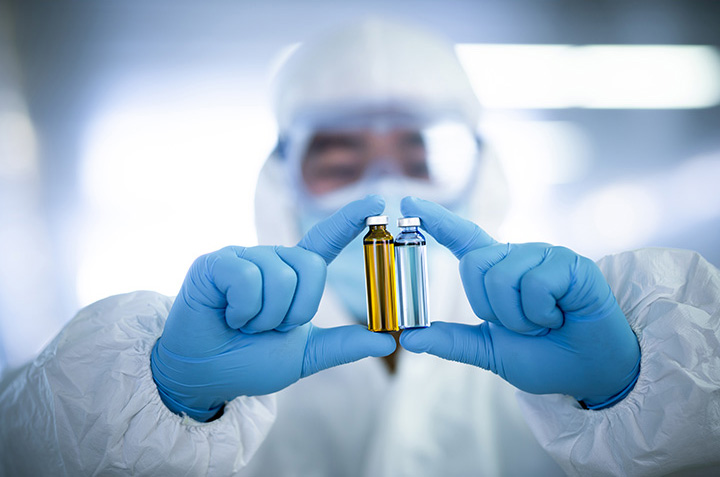
Protection against cytostatic contamination
To ensure the highest possible standards of work in sterile environments, especially at hospital when preparing cytostatics, it is necessary to use specialized protective clothing. In order to meet the established requirements, it is manufactured in controlled production conditions, such as a clean room, thus ensuring the lowest possible level of spreading of free particles and meeting the requirements of PN-EN ISO 9073-10:2006 standard.
more
Protection against cytostatic contamination
To ensure the highest possible standards of work in sterile environments, especially at hospital when preparing cytostatics, it is necessary to use specialized protective clothing. In order to meet the established requirements, it is manufactured in controlled production conditions, such as a clean room, thus ensuring the lowest possible level of spreading of free particles and meeting the requirements of PN-EN ISO 9073-10:2006 standard.
The Salveguarda materials have been designed with the highest level of safety and comfort of use in the CLEAN ROOM zone. The Salveguarda materials dedicated to work in sterile conditions are used in personal protective equipment under the MATOGUARD LAB brand. The process of manufacturing of suits under the BOM brand: cutting, sewing, sealing the seams and packing them into packages for sterilisation is conducted in sterile conditions. Packaged suits are sterilised with ethylene oxide, ensuring sterility and safety of use in the most stringent clean work conditions.
Protection against infectious agents
Never before has the epidemic threat been so important as it is today. The Salveguarda materials have been used many times for the production of suits and other personal protective equipment accessories intended for use during SARS, MERS, avian influenza or swine influenza epidemics. They have played the most important role during the currently prevailing COVID-19 pandemic.
more

Protection against infectious agents
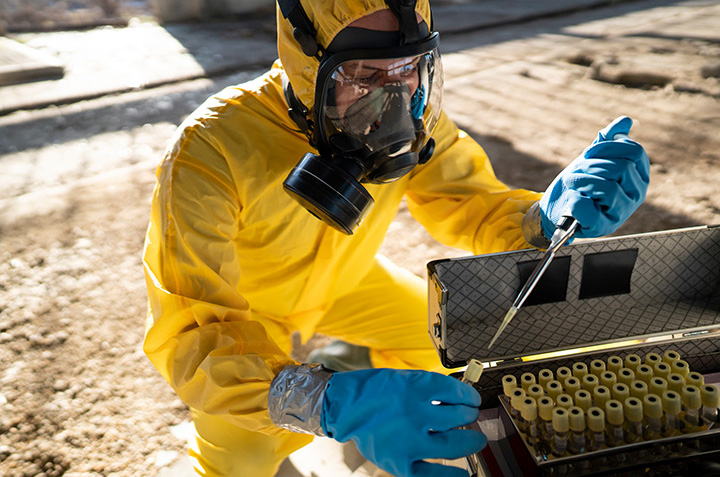
Protection against chemical agents
In the chemical industry, workers are exposed to hazards to health and life on a daily basis caused by hazardous chemical compounds in liquid, gas or solid form. The new Salveguarda CHEM 4502 and Salveguarda CHEM 6002 laminates form a protective barrier against inorganic chemicals protecting a body of a user exposed to high levels of chemicals.
more
Protection against chemical agents
Protection against chemical agents
In the chemical industry, workers are exposed to hazards to health and life on a daily basis caused by hazardous chemical compounds in liquid, gas or solid form. The new Salveguarda CHEM 4502 and Salveguarda CHEM 6002 laminates form a protective barrier against inorganic chemicals protecting a body of a user exposed to high levels of chemicals. The materials are resistant to 480 minute long exposure to concentrated acids or bases, as well as to many other chemical agents (even pressurised), as specified in PN-EN ISO 6529:2005. Laminates are designated for manufacturing of suits protecting against chemical and biological hazards, category III, type 3, 4, 5, and 6. They offer an excellent protection against contamination with infectious agents or radioactive contamination. Salveguarda CHEM 4502 and Salveguarda CHEM 6002 laminates are available as standard in yellow, grey and navy blue, but their colour can also be customised as required by an individual customer. Furthermore, we offer Salveguarda CHEM 2001 film that can be used to seal the finished product of the same colour as the laminate for the suit. When additional resistance to selected organic chemicals is required, the use of specialist Salveguarda FORCE laminates is required, offering higher protection. Detailed information on resistance to selected chemicals is provided in the table in the information leaflet.
Protection for the industry
Protective suits represent a crucial component in personal protective equipment. They are used in the automotive, food, agriculture, petrochemical and electronic industries, as well as wherever there is a risk of body or clothing contamination. The Salveguarda materials are resistant to effects of hazardous particles, such as lead, asbestos or mould, as well as of a number of chemical compounds, depending on the material design.
more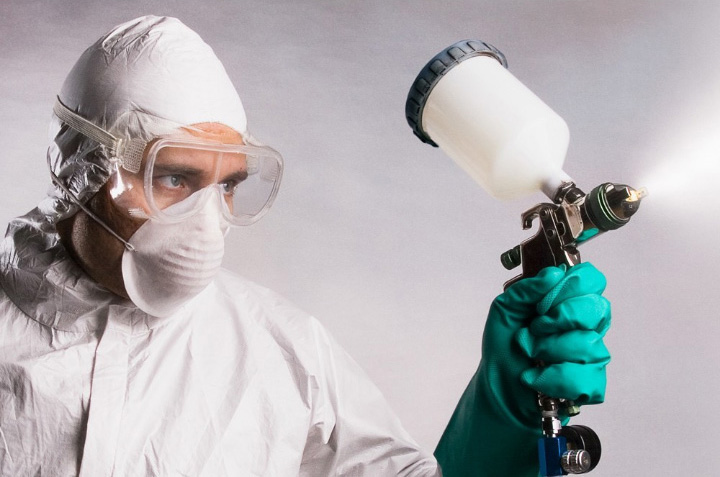
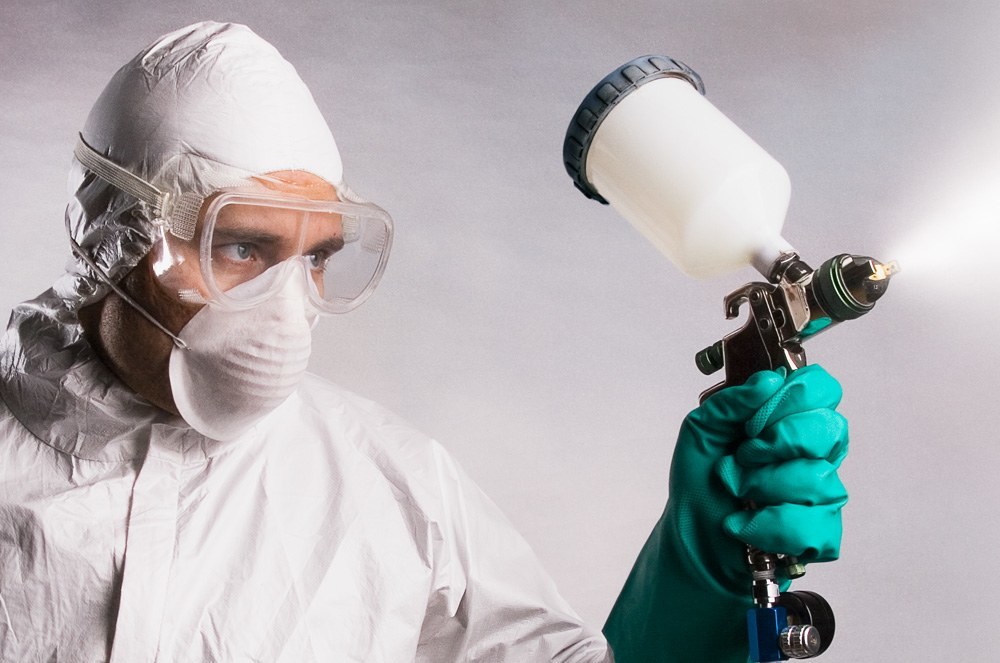
Protection for the industry
Protective suits represent a crucial component in personal protective equipment. They are used in the automotive, food, agriculture, petrochemical and electronic industries, as well as wherever there is a risk of body or clothing contamination. The Salveguarda materials are resistant to effects of hazardous particles, such as lead, asbestos or mould, as well as of a number of chemical compounds, depending on the material design. The antistatic properties, in accordance with EN 1149-5, ensure protection against accumulation of electrostatic charges that may form an electric arc resulting in ignition or an explosion in the workplace. The two-layer Salveguarda laminates have antistatic properties, usually ensured on the inner side of the protective clothing, and in special cases, the three-layer material protects against electrostatic discharges both on inside and outside surfaces of the suit. When protection against electromagnetic radiation in a range of 50 kHz to 5 GHz is required, the use of aquascreen materials is recommended.
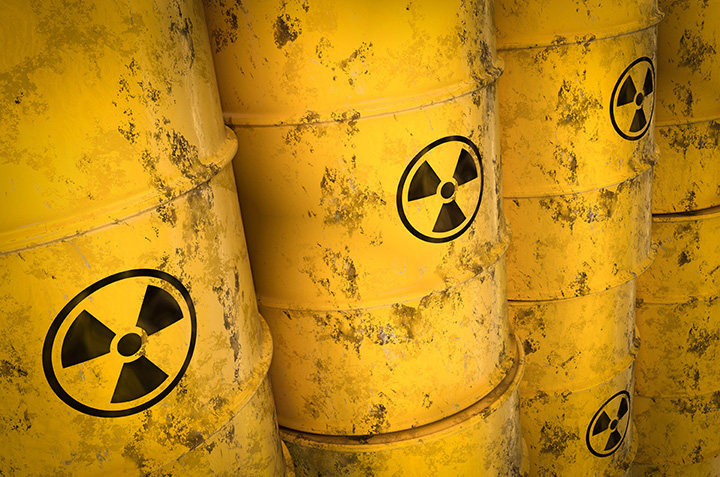
Protection against radioactive contamination
Disposable protective clothing is used to minimise a risk of penetration of contaminated radioactive particles, and thus protect the skin, hair and clothes against their effect. Salveguarda AIR and Salveguarda CHEM laminates.
more
Protection against radioactive contamination
Disposable protective clothing is used to minimise a risk of penetration of contaminated radioactive particles, and thus protect the skin, hair and clothes against their effect. Salveguarda AIR and Salveguarda CHEM laminates. Depending on the chemical contamination that may accompany the radioactive contamination, an adequate quality and design of the material used for personal protective equipment needs to be selected. Such protective clothing is designed to be worn in contaminated places. For its safe use and to minimise a risk of recontamination, the protective clothing must be taken off immediately after use, observing required safety procedures, and disposed of at a designated location. When Salveguarda CHEM laminates are used, the colour of the material can be customised according to the needs of the individual customer.
Protection against contamination with pesticides
Plant protection agents (PPA) are also known as pesticides or phytopharmaceuticals. They are used to protect crops, mainly against fungi (fungicides), insects (insecticides) and weeds (herbicides). The use of pesticides is strictly regulated. Farmers must observe rules specified in a product label and use relevant personal protective equipment.
more

Protection against contamination with pesticides
Plant protection agents (PPA) are also known as pesticides or phytopharmaceuticals. They are used to protect crops, mainly against fungi (fungicides), insects (insecticides) and weeds (herbicides). The use of pesticides is strictly regulated. Farmers must observe rules specified in a product label and use relevant personal protective equipment. For this purpose, we have designed Salveguarda AIR and Salveguarda CHEM laminates. For contacts with plant protection products, CE-certified protective clothing of category III type 4 is recommended, protecting against aqueous aerosols. In the case of exposure to active ingredients in form of solid particles, the use of clothing with a minimum resistance class of category III type 5 is recommended. When clothing of Salveguarda AIR is used, depending on chemicals used, it is recommended to wear additional apron made of Salveguarda CHEM or Salveguarda FORCE at locations with the highest exposure to chemicals.
Comfort and safety
We offer an extensive range of Salveguarda laminates designed with the users’ safety and comfort of work in mind. Regardless of the type of a hazard or work environment, protective suits made of Salveguarda laminates meet the highest requirements of the applicable standards, and represent an ideal combination of protection, resistance, vapour permeability and comfort. On individual request, we can customise the laminate colour and design, to meet the requirements of the most demanding customers.
Polimery
Plastica Sp. z o.o. wspiera akcję społeczną POLIMERY PRZYJAZNE CZŁOWIEKOWI, POTRZEBNE LUDZIOM
Niewiele jest spraw, co do których Polacy są zgodni. Jedną z nich jest fatalny publiczny wizerunek tworzyw sztucznych. Przemysł tworzyw stał się dyżurnym „chłopcem do bicia” w Polsce i UE, jest obwiniany za wszelkie błędy i wypaczenia naszej cywilizacji. Czas na podjęcie działań, które w rozsądnej perspektywie pozwolą zmienić negatywne społeczne nastawienie wobec tworzyw.
Przede wszystkim najwyższy czas na wyrugowanie z przestrzeni publicznej koszmarka językowego „tworzywa sztuczne”. Ten termin natychmiast odrzuca każdego normalnego człowieka, jego ocieplenie i zmiana wizerunku na pozytywny wydaje się niemożliwa, albowiem nic co „sztuczne” nie może być przyjazne człowiekowi. Dlatego proponujemy zastąpienie koszmarka językowego terminem „tworzywa polimerowe”, a szerzej POLIMERY. Nazwa POLIMERY oddaje istotę rzeczy i nie jest obciążona negatywnymi asocjacjami i skojarzeniami wytworzonymi wokół koszmarka językowego. Jest nawet sympatyczna i, jak widać po logo akcji, da się za jej pomocą komunikować treści mające odzwierciedlenie w rzeczywistości.
Pamiętajmy, że jak mówi Pismo, na początku było Słowo. Język ma kluczowe znaczeniu w międzyludzkiej komunikacji i tworzeniu korzystnego lub negatywnego wizerunku. Krótko mówiąc: język tworzy rzeczywistość.
Celem akcji jest rozpropagowanie terminu POLIMERY, który w niedalekiej przyszłości powinien zastąpić koszmarek językowy. Przemysł polimerowy musi się zacząć w końcu bronić. Polimery są niezbywalnym elementem naszej cywilizacji i tylko od człowieka, od nas samych zależy, jak będą nam służyć.
Wprowadzenie terminu POLIMERY do dyskursu publicznego pozwoli rozpocząć wiele pozytywnych działań wizerunkowych we współpracy z mediami i organizacjami społecznymi.
Zmiana wizerunku branży powinna ożywczo wpłynąć na sam biznes. Zejście z linii strzału ekologów, mediów, polityków, innych grup opiniotwórczych, powinno przynieść mierzalne biznesowe efekty. Taki stan rzeczy na pewno zostanie zauważony przez inwestorów zagranicznych. Wreszcie, może to być sygnał do konsolidacji przemysłu polimerowego, co zaowocuje wzrostem siły i znaczenia tej branży w całej gospodarce.






